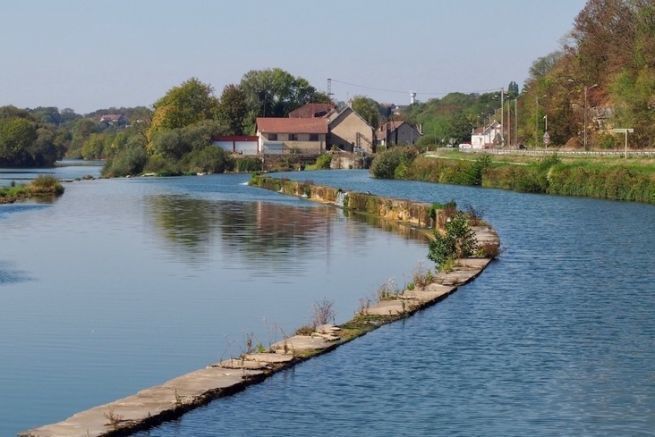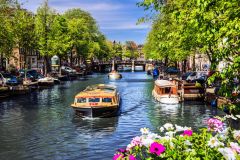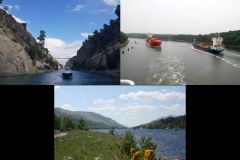Although it is above all a link between Northern Europe and the Mediterranean, the Rhone-Rhine Canal has many attractions, starting with the way it follows the valley and the bed of the Doubs whenever it can. An intimacy that the navigator shares with pleasure, passing from one to the other at each meander. It is only downstream from Dole that the 2 separate. The canal flows into the Saône at Saint-Symphorien, while the Doubs meets it at Verdun-sur-le-Doubs.
Under the walls of the historic district of Dole
The port of Dole adjoins the tannery district. Workshops and mills of yesteryear have now been converted into restaurants and galleries that border a pretty flowery canal. You can get lost in the open cellars and vaulted passages. If you play at being a "passe-muraille", you will find a wash house here, and the house where Louis Pasteur was born here. The city is welcoming and its paved streets are pleasant and lively. In the evening, when you return to the boat, don't miss crossing the footbridge to enjoy the low-angled light that usually gilds the boats moored in front of the old town and the bell tower of the collegiate church.
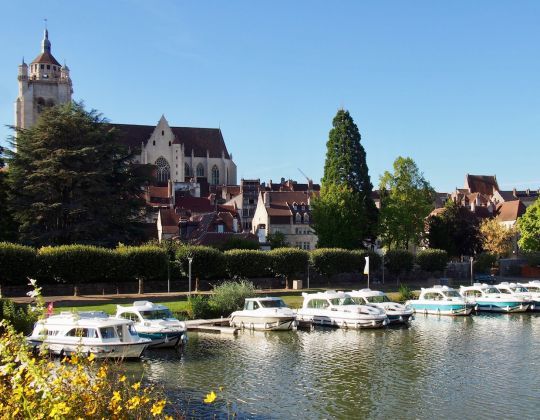
Fingertip navigation
The first locks are in the canal. At the first one he passes, the navigator is given a remote control which allows him to start the maneuver from the helm station, by simply pressing "Up" or "Down". Some of them have their 2 doors permanently open. These "guard locks" are only closed in case of flood to avoid the flooding of the canal by the Doubs. In normal time, we pass them simply by slowing down. Stopping on the river at the foot of the superb cliff of Roche-sur-Nenon, one should not miss the path that leads to the plateau and the chapel from where the view extends very far over the valley.
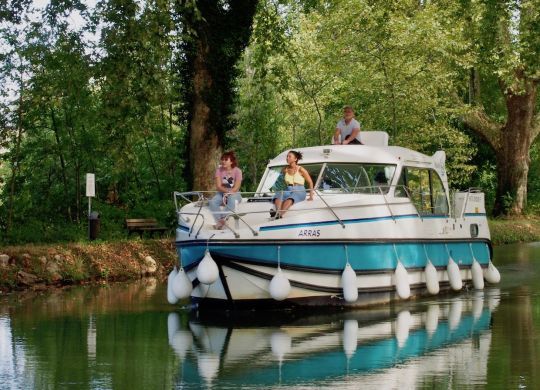
We follow the channel with the estimate
On this natural section, one discovers the signposting on the bank: instead of the traditional marking, panels on land indicate the distance of the channel from it. This system is all the more surprising for the neophyte as the transparency of the water often lets you see rock banks on both sides of a channel as narrow as it is theoretical... The portions of the channel are cluttered with weeds and water lilies which do not incite to approach the banks. The bell towers that can be seen would incite to stop in the villages, but the absence of a pontoon and the uncertain bottom discourage to try the adventure of a wild landing.
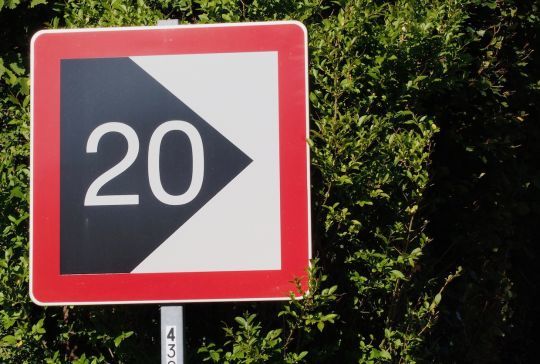
The canal and the river follow each other and sometimes merge
In fact, one crosses mostly pleasure boats in transit, often Scandinavians on their way to the Mediterranean. However, the landscapes are strong and endearing as upstream of lock 62 of the Moulin des malades where the canal is separated from the Doubs only by a low curved wall on which herons and kingfishers have their fishing posts. The staircase effect is sumptuous! Beautiful also, the underground of Thoraise curiously occulted by a liquid curtain which stops only when the boat passes. There are just enough drops left for a small shower, but the play of light and mirrors decorate the crossing which leads at right angles to a very beautiful reach bordered by cliffs and dominated by the ruins of the castle of Montferrand.
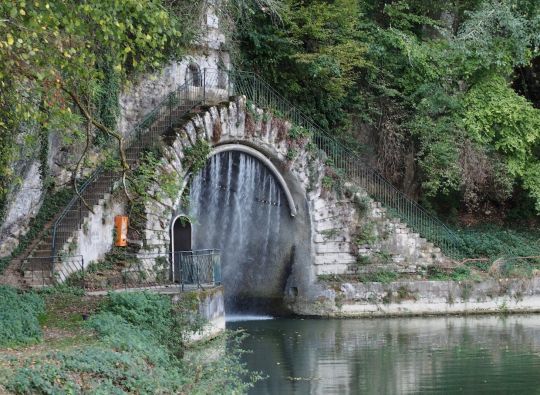
The loop loops below the citadel
But soon, the imposing silhouette of the Citadel announces Besançon. The old city is surrounded by a loop of the Doubs river that can be followed if its draught allows it. If not, we will cut through the Tarragnoz tunnel, dug in the rock, 118 meters below the Citadel. At the other end of the tunnel and facing the Cité des Arts, the port is pleasant and you can feel the young, student and pleasant atmosphere of the city. Along the loop, the high facades are reflected in the waters of the Doubs, as is the statue of Jouffroy d'Abbans, the first person in the world to have built a mechanically propelled boat in 1776!
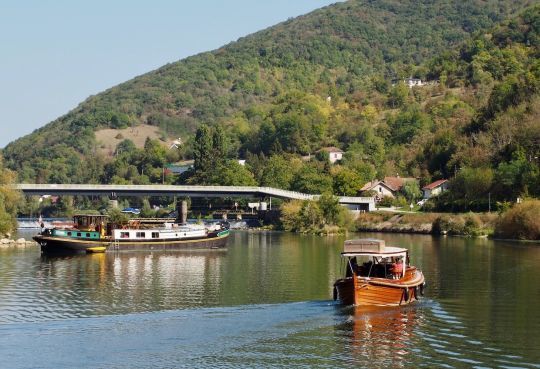
A valley with wooded and steep banks
Upstream, nature takes back its rights while the Citadel still points its nose above the relief. The further upstream you go, the more attention you need to pay to navigation: the sea grass beds and the rock banks visible in transparency confirm and complete the channel markings. The port of Deluz is managed by Claude Lorand of the Doubs plaisance shipyard, installed in an old paper mill. The landscape is layered and the cow pastures are lost in cliffs and high forests. In the heart of this preserved nature, we continue to the stop of Baume-les-Dames, decorated with a restaurant which holds terrace directly on the channel.
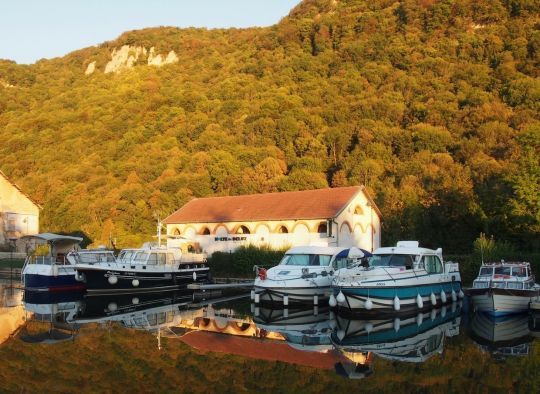
In this environment, one can only tremble in retrospect when thinking of the upheavals that would have been caused by the digging of a large gauge Rhine-Rhone link, which was once envisaged. Even if this waterway is notoriously under-equipped with pontoons and the tourist attractions are concentrated in the cities, the Doubs and the canal constitute a beautiful river experience to be lived!
Local tips and tricks :
- La Fromagerie comtoise is a Doloise institution. The Garnichets offer Comté, Mont d'Or and Cancoillotte, but also wine, cold cuts and cookies. Nothing but local products!
- The remote control that controls the passage of the locks is geo-located. It is recommended to turn it on 1 or 2 minutes before arriving at the lock so that the GPS is located.
- Be careful not to hit the wrong key... In this case, the lock is prepared in the wrong direction and the system does not detect a boat, so it goes to safety.
- It is not always easy to estimate the distance from the shore to locate the channel. You can use the length of the boat to calibrate your pifometer.
- There are few stops and some villages that look attractive from the water are difficult to access. The most practicable quays and pontoons are those of Rochefort-sur-Nenon, Ranchot and Thoraise.
- The underground of Thoraise is blocked by a liquid curtain which stops as soon as the boat moves forward.
- The Besançon loop is worth the detour but the important draughts will have to use the Tarragnoz tunnel.
- The citadel is well worth the effort to climb up for a visit!
- Just across from the Besançon Museum of Time, don't miss the Utinam boutique to discover P. Lebru's watchmaking creations.
- The Doubs plaisance yard in Deluz can take out boats up to 20 tons.
The Rhone-Rhine Canal in brief:
- Length: 110 km from Saint-Symphorien to Baume-les-Dames
- 36 electrified locks remotely controlled by the user
- Speed limit of 10 km/h in river and 8 km/h in canal
- Vignette and navigation tax : Yes
- Navigation manager: VNF
- Size: 38,70 x 5,20 m
- Minimum air draft : 5,20 m
- Minimum draught : 1,80 m
- Renter : Nicols in Dole, Le Boat in Saint-Jean-de-Losne, Les Canalous in Pontailler-sur-Sâone
- Period of unemployment: the canal is navigable all year round, except when the Doubs is flooded
- Smartphone application : no

 /
/ 